The Golden Bay orchard dedicated to finding the perfect feijoa
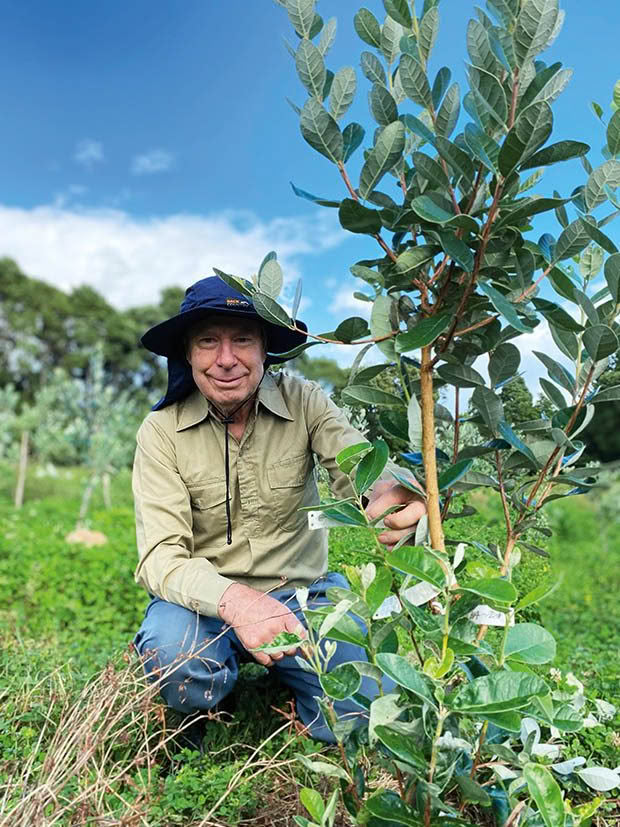
Nigel Ritson has spent the last 35 years breeding feijoas, searching for the perfect fruit. Nina Hindmarsh visited his orchard to find out what drives his dedication to the plant.
Words and photos: Nina Hindmarsh
Who: Nigel Ritson
Where: Rangihaeata, Golden Bay
What: Two-hectare feijoa orchard, nursery, and breeding programme
When Nigel Ritson first started growing feijoas for commercial sale more than thirty years ago, he was pretty sure he’d work himself into the ground and make very little money.
He was right. “But still, somehow it’s been worth doing,” he says.
Nigel’s orchard and nursery, Foretaste Feijoas, is located near Tākaka, in Golden Bay. The area northwest of Nelson provides ideal growing conditions for the popular fruit, native to South America. While Nigel’s orchard produces fruit for commercial sale, it’s his breeding programme – and a fervid obsession with breeding the perfect feijoa – that has become his life’s work and passion.
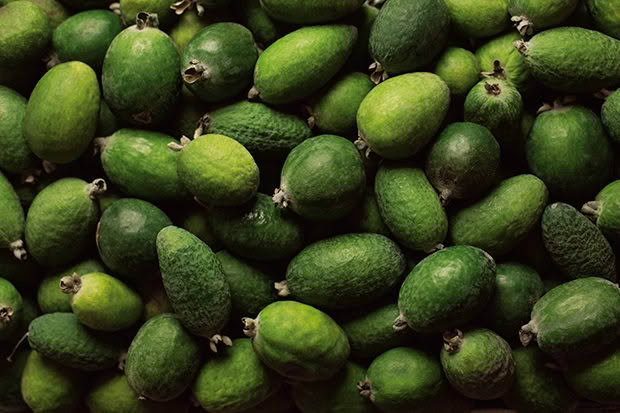
The first westerner to document Feijoa sellowiana, also known as “pineapple guava”, was German botanist Friedrich Sellow who found the fruit in the jungles of southern Brazil in 1815. It was later introduced to Europe and North America by French botanist Édouard André, and later brought to New Zealand in the early 1900s from Australia.
Nigel owns the plant variety rights for four cultivars: ‘Waitui’, ‘Kawateri’, ‘Waingaro’, and ‘Tākaka’. And while he grows these for commercial sale and home use, he’s still working to breed a new and better variety – a fruit that’s big and round, abundant, resistant to fungal attack, tastes delicious and stores well, even after a hard growing season.
He likens his mission to a geneticist trying to create a top athlete who also wins the beauty contest. He’s still not sure if it’s possible, but demanding perfection from a plant has only taught him how to live with one failure after another. “I pretty quickly learned it’s not about the exception. It’s mostly learning to take risks and live with failure. It can be punishing.”
THE FIRST BUCKET
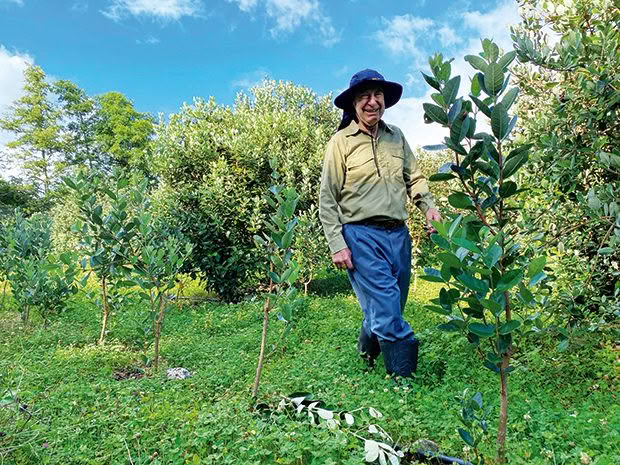
Nigel’s love story with the feijoa began half a lifetime ago – in 1989. After his marriage broke down, Nigel was left on his own – a solo dad of two preschool boys, unable to afford the mortgage. One day, during a period of “terrible grief”, he was trying to build a canoe in the backyard of his Porirua home. His boys were hungry, so Nigel went and picked them a bucketful of feijoas that had fallen from the tree in the front lawn. After a few minutes, the boys finished the whole bucket, and they wanted more.
Soon after, Nigel purchased a cheap block of land near Tākaka, hoping to use the property to explore an interest in horticulture. Intending to grow lucrative avocados, Nigel quickly discovered the soil was pakahi, a type of infertile heathland. A local grower said Nigel could probably only grow apricots, or shallow-rooted feijoas.
He tried apricots, but they were “hopeless in the humidity”, and he ripped them out. Fondly remembering the day his boys had scoffed bucketloads of feijoas, he went ahead with planting a section of his property with 600 seedlings. These were given to him by an experienced grower, and were ex-Department of Scientific and Industrial Research (DSIR) plants. The government had just shut down its feijoa research breeding programme, and needed them gone.
For the first decade, Nigel grew the fruit to sell to wholesalers and retailers. It was a busy time – working his day job at the milk factory, and later, the supermarket while raising his two boys and tending to his orchard in his spare time.
MAKING THE CUT
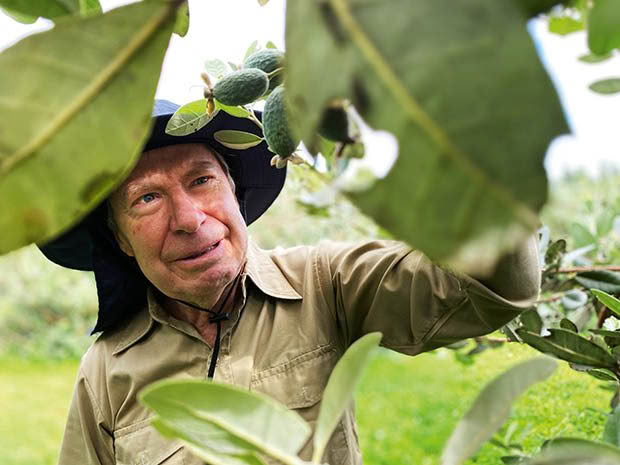
Of the first 600 ex-DSIR seedlings, only two of the original plants remain in the orchard today. Over many years, thousands of trees went through Nigel’s strict culling system, not meeting certain standards for flowering, taste, appearance, size, shape, and storage capacity.
Nigel admits the majority of his cross-breeding work has resulted in failure, but every now and again he’ll breed a delicious, large, perfectly round fruit, and it’ll restore his faith in his mission. He’s fastidious and selective, and reckons he’s tasted up to 100,000 feijoas in his time; savouring and spitting out a multitude of different flavours from hints of lemon to rose perfume. Some feijoas have the more obvious flavours of pineapple, passionfruit, and grainy apple. But others have been on the more “bizarre” flavour side, such as one weird variety that tasted like “chewy steak”.
Several decades ago, Nigel got his hands on some new, Brazilian plants. He suspects these were smuggled in as seeds from the Amazon rainforest by a New Zealand botanist. The new plants really shook things up in his breeding programme, and Nigel began developing a large number of crossbreeds every year. He was amazed at their big, beautiful flowers, with luscious petals. Some individual fruits weighed up to 300 grams.
They also offered the most extraordinary taste complexity. “The flavours were all tangled up. I hadn’t experienced anything like it in my life.
“Most of them were really horrible. I was sure some were toxic. Some were metallic, others tasted like industrial chemicals. During tasting, the comment I wrote next to some of them was TC, which was short for ‘toilet cleaner’. You’d never, ever want to eat it.”
He did six years’ worth of data collection and culling of the Brazilian plants, trying to breed new and better cultivars. He worked himself so hard he sometimes thought he’d die from exhaustion. “I’d pick dawn to dusk and go right through the whole orchard, then start again. I was measuring and weighing and tasting every plant in every row and collecting data on every single one.”
Cross-breeding with the wild Brazilian plants presented plenty of surprises. One produced yellow and green stripes like a Zebra, he says. “Some of them tasted really good when they were juveniles, but as they matured, gave really horrible fruit and thick, ghastly skin.”
SCIENTIFIC POTENTIAL
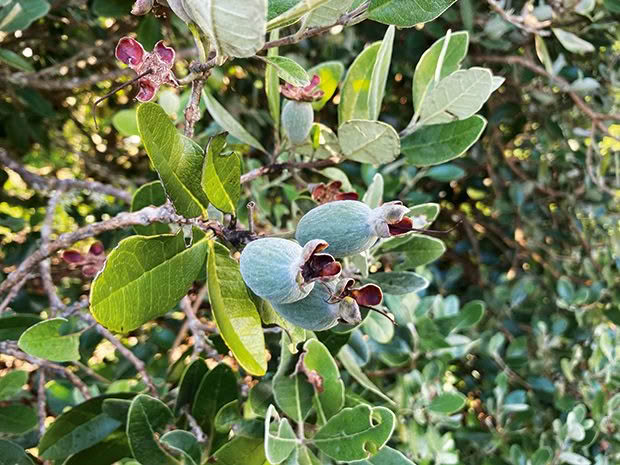
During his breeding journey, Nigel became convinced there were pharmaceutical properties in the Brazilian fruits. He contacted Victoria University of Wellington, and asked its researchers if they would be interested in testing the antifungal and antibacterial properties of his feijoas. In 2017, Nigel’s very own feijoas became the subject of a study, which identified compounds in the peels and pulp of 16 feijoa varieties: a handful of the most popular commercial varieties, and six of Nigel’s cultivars. The scientists found a huge variation of the pharmaceutical compounds between the individual varieties. Two of Nigel’s cultivars – including the wild Brazilian cross – were found to be the most bioactive. Described in the 2018 study as “potently” antifungal, the fruit peel was found to contain compounds that inhibited the growth of candida, without damaging human cells or gut bacteria.
Nigel was thrilled. After decades of exhaustive effort searching for the holy grail of feijoas, he thought he’d finally see the fruits of his labour. His dream was to fund an internationally significant breeding programme from his royalties, and see a high-value feijoa peel extract industry set up to produce medicines, which would incentivize the whole feijoa industry. However, the university’s commercial department chose not to apply for a provisional patent prior to the paper’s publication. Nigel’s feijoa dream flopped. He was heartbroken – a little bitter, even – and says he’s still getting over the loss.
“Not just for my own personal effort, but for the New Zealand economy and the potential for a feijoa industry. With this largely undiscovered chemistry [of feijoas], there remains great potential for discovery that might benefit humans.”
Nigel describes the feijoa industry in New Zealand, and internationally, as “fragmented and undeveloped”. He claims that growers are still planting with poorly-performing varieties, and selling fruit to large retail outlets individually. This results in low returns for the orchard owners, poor quality feijoa produce for consumers, degradation of the feijoa image, and stagnation and saturation of the market.
Currently, Nigel is doing further crossings with Brazilian varieties, still trying to find the perfect fruit. “There could be other new flavours to be uncovered, and potentially new pharmaceutical compounds. I’m probably an idiot because it’s just going to lead to another eight years of hard work, and I’m getting older.
“But I should give it a try.”
NIGEL’S TOP TIPS FOR FEIJOA TREE GROWING
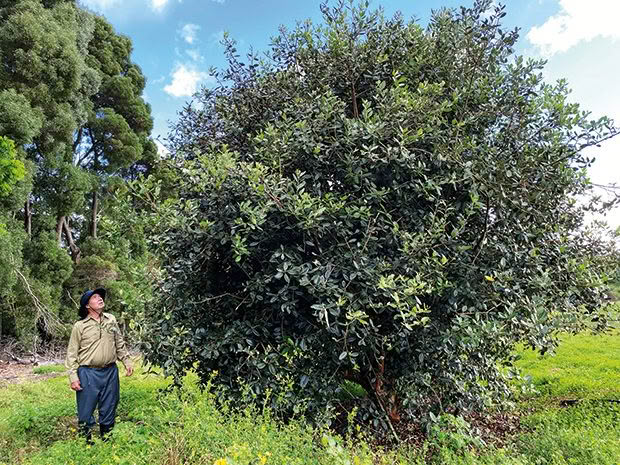
Despite effortlessly appearing on roadside and backyard trees throughout the North Island, feijoas, Nigel says, can be tricky plants to grow. While each variety and cultivar is unique, it is not a given that a plant will perform well – there are dozens of different factors that can contribute to the taste, size and quantity of a fruit.
For example, a relative of his once planted one of his best cultivars, ‘Takaka’ – which has been bred for the flavour and size of the fruit – on their property in Wellington. The results were horrible, with the fruits turning out thin and elongated. “I’ve never seen fruit like that. It was probably the combination of terribly poor soil on a bank with shocking water availability and poor nutrition,” he says.
Because feijoas are influenced by so many factors, Nigel says it doesn’t matter if you grow the mainstream varieties like ‘Apollo’ or ‘Unique’, or a cultivar like ‘Takaka’, it all comes down to your soil quality and how you treat the plant.
If its being provided with the best inputs, Nigel says a self-fertile plant like ‘Takaka’ should yield quality fruit within one or two years.
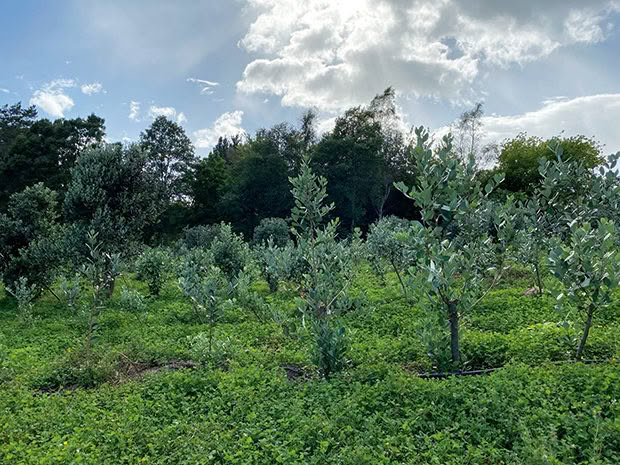
Here are some of Nigel’s top feijoa tips:
• Plant in a sunny spot. Feijoa trees need high light intensity to flower and produce tasty fruit, although a bit of shade early or late in the day is okay.
• Be mindful of drainage. Though they are shallow-rooted, feijoas can get root rot from frequently waterlogged or poorly draining soil. While its depends on the permeability and gradient of your soil, mounding around stand-alone trees is useful to drain away excess moisture. In his breeding orchard, he has raised rows that run down a slope. These are raised 30cm or more after the soil has settled and been compacted down by rain.
• Water plants well. Water demand during fruit swell for an optimum crop can be surprisingly high during droughts, intense heat, and high wind. Nigel suggests hundreds of litres per week per plant, not just a few buckets full. Sufficiently-sized irrigation ponds are a good long-term investment for home or commercial orchards. Feijoa plants are hardy, and can look healthy for a long time in a drought. Then suddenly, over just a few days, the leaves begin to curl, indicating that the plant is dying. Get water to them quick, but don’t overwater a badly stressed plant as it could easily get root rot.
• Apply fertilisers. Artificial, sulphur-based fertilisers with trace elements can make all the difference to plant growth and health on low-fertility soils. However, applying these during fruit swell can ruin the taste of the fruit and shorten its storage life. Applying wood chips, bark, manure, seaweed and other organic matter foster good soil and plant health with likely improvements in fruit taste.
Love this story? Subscribe now!
 This article first appeared in NZ Lifestyle Block Magazine.
This article first appeared in NZ Lifestyle Block Magazine.
